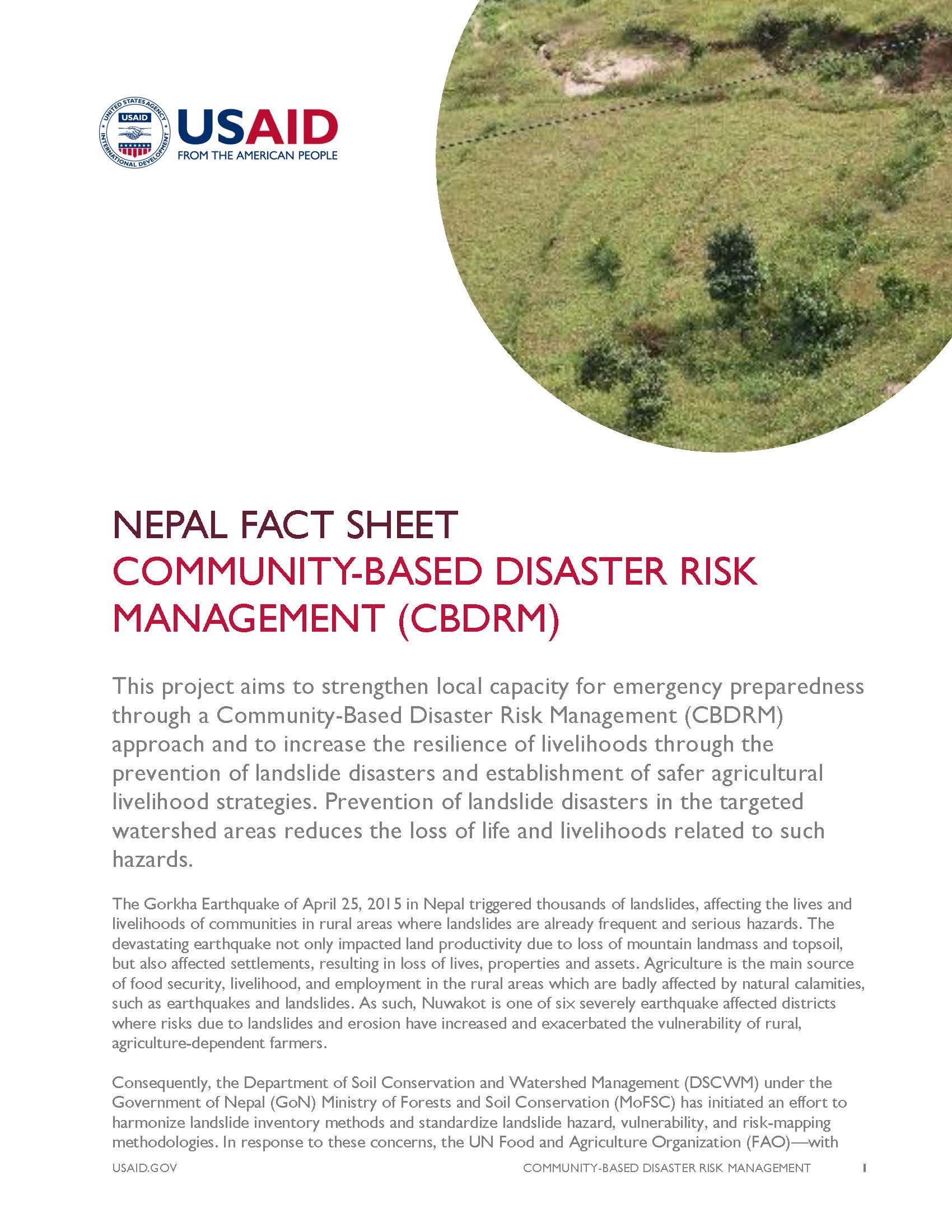This project aims to strengthen local capacity for emergency preparedness through a Community-Based Disaster Risk Management (CBDRM) approach and to increase the resilience of livelihoods through the prevention of landslide disasters and establishment of safer agricultural livelihood strategies. Prevention of landslide disasters in the targeted watershed areas reduces the loss of life and livelihoods related to such hazards.
The Gorkha Earthquake of April 25, 2015 in Nepal triggered thousands of landslides, affecting the lives and livelihoods of communities in rural areas where landslides are already frequent and serious hazards. The devastating earthquake not only impacted land productivity due to loss of mountain landmass and topsoil, but also affected settlements, resulting in loss of lives, properties and assets. Agriculture is the main source of food security, livelihood, and employment in the rural areas which are badly affected by natural calamities, such as earthquakes and landslides. As such, Nuwakot is one of six severely earthquake affected districts where risks due to landslides and erosion have increased and exacerbated the vulnerability of rural, agriculture-dependent farmers.
Consequently, the Department of Soil Conservation and Watershed Management (DSCWM) under the Government of Nepal (GoN) Ministry of Forests and Soil Conservation (MoFSC) has initiated an effort to harmonize landslide inventory methods and standardize landslide hazard, vulnerability, and risk-mapping methodologies. In response to these concerns, the UN Food and Agriculture Organization (FAO)—with support from USAID’s Office of U.S. Foreign Disaster Assistance (USAID/OFDA) is providing technical assistance to the DSCWM, supporting slope stabilization and landslide mitigation with proven technologies and experience. The project is a pilot initiative, demonstrating appropriate landslide treatment and mitigation techniques using the bi-engineering approach to reduce crisis in watershed areas.
PROJECT OVERVIEW
The MoFSC and the Ministry of Finance (MoF) have endorsed the project working modalities in December 2016. The DSCWM has formed a Project Steering Committee (PSC) with Focal Person for this program at the national level. The District Soil Conservation Office (DSCO) has nominated Focal Person as instructed by the DSCWM at local levels. The project team, along with Focal Persons, visited and finalized the priority sites for landslide treatment and mitigation together with livelihood support activities through Focused Group Discussion (FGD) among the direct beneficiaries.
PROJECT ACTIVITIES
- Received endorsement of the project from the MoF and MoFSC with the nomination of Focal Persons at national and district levels. The GoN focal persons, together with the FAO team, had a joint visit to the project sites and finalized a list of critical landslide areas for immediate treatment and mitigation, as well as several livelihood support activities.
- Selected a local NGO Service Provider based on a competitive basis in line with FAO Standard Procurement Guidelines.
- Provided training on nursery management and expects to produce 50,000 saplings of different species suitable for soil conservation and fodder trees.
- Developed user-friendly Agricultural Hazard and Vulnerability Mapping (AHVM) Tool Kit and short video as base line information.
- Mobilized the Community Forest User Groups (CFUG) in all three Village Development Committees (VDCs) and formed sub-groups within the CFUG for implementation of project activities.
- Completed the detailed survey, estimates, and designs in all three critical landslide areas for treatment and mitigation works.
- Other regular ongoing activities include:
- Support for landslide treatment and mitigation using suitable bio-engineering approach
- Support local agriculture-based livelihood activities identified during the Focus Group Discussion
- Regular nursery management and community plantation (CFUG)
- Regular coordination among the government agencies, communities, and other relevant stakeholders working in landslide treatment and mitigation
- Capacity building of beneficiaries and government officials on the bio-engineering approach in landslide treatment and mitigation and Early Warning System (training, exposure visits, and orientation etc.)
- Develop community level “Watershed Management Plan” (Darkhukhola sub-watershed Level)
- Develop the Early Warning Systems at local level
- Regular reporting and documentation of lessons learned and success stories
RESULTS ACHIEVED
The expected result of the project is to support earthquake-affected communities of 3 VDCs in Nuwakot’s Darkhukhola sub-watershed with appropriate technologies on landslide treatment and mitigation, and bolster safer livelihood activities to reduce loss of life and livelihoods due to landslide-related hazards.








Comment
Make a general inquiry or suggest an improvement.